Imagine growing crisp lettuce or fragrant basil in your kitchen without dirt. Aeroponics makes this possible by misting plant roots with nutrient-rich water. This method uses 95% less water than traditional gardening while accelerating growth rates by up to 3 times, according to agricultural studies.
You’ll discover how this soil-free approach lets you cultivate herbs, leafy greens, and even strawberries year-round. Unlike conventional methods, aeroponic systems deliver oxygen and nutrients directly to roots, creating ideal conditions for thriving plants.
We’ll walk through choosing the right equipment and maintaining your setup. Brands like Airgarden simplify the process with pre-configured spray intervals, perfect for first-time growers. You’ll learn to avoid common pitfalls while maximizing yields.
By the end of this resource, you’ll know how to:
- Select plants that flourish in mist-based environments
- Optimize water and nutrient delivery
- Harvest fresh produce every few weeks
Whether you want to reduce grocery bills or enjoy pesticide-free meals, aeroponics offers a sustainable solution. Let’s explore how you can start growing tomorrow’s dinner tonight.
Understanding Aeroponics and How It Works
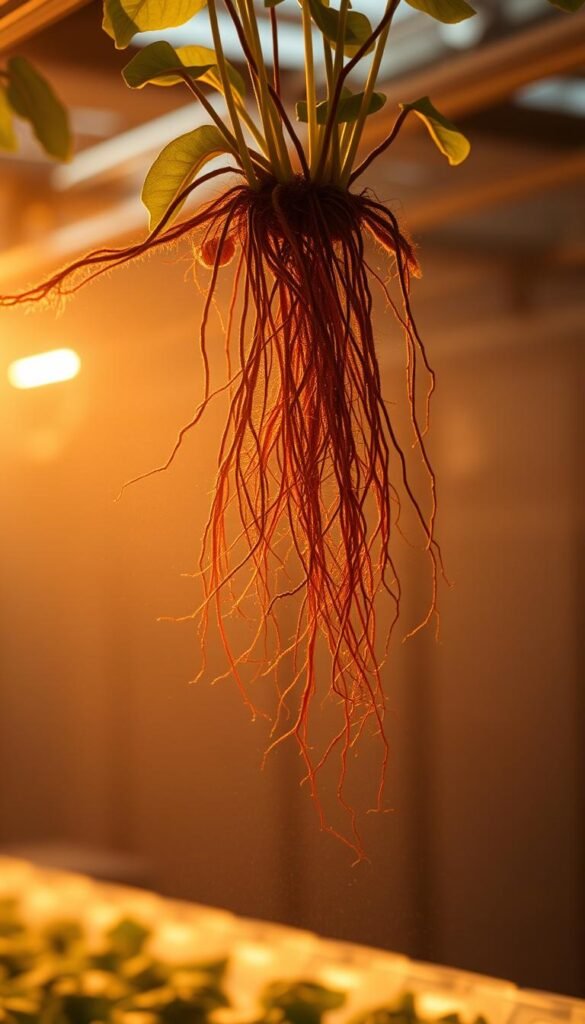
Discover a revolutionary way to cultivate crops without a speck of dirt. Aeroponics suspends plants in air while misting their roots with precise nutrient blends. This method skips soil entirely, allowing roots to absorb oxygen and minerals more efficiently.
What Is Aeroponics?
Plants grow in net pots or foam collars, with roots dangling in a closed chamber. A high-pressure system sprays fine mist every few minutes, coating roots with water and nutrients. Unlike hydroponics, which submerges roots in liquid, aeroponics maximizes oxygen exposure. This boosts nutrient absorption by up to 40%, research shows.
Aeroponics vs. Traditional and Hydroponic Gardening
Traditional soil gardening requires constant watering and weeding. Hydroponics uses 10x more water than aeroponics, according to USDA data. Here’s how they stack up:
| Method | Root Environment | Water Use | Growth Speed |
|---|---|---|---|
| Soil | Buried, limited oxygen | High | Standard |
| Hydroponic | Submerged in liquid | Moderate | 1.5x faster |
| Aeroponic | Exposed to air/mist | Low | 3x faster |
Urban growers love aeroponics for compact setups. You can stack vertical towers in apartments or garages. Since there’s no soil, pests rarely invade. Just monitor pH levels and mist cycles – your plants will thank you with lush leaves and juicy fruits.
Exploring the Benefits of Aeroponic Gardening
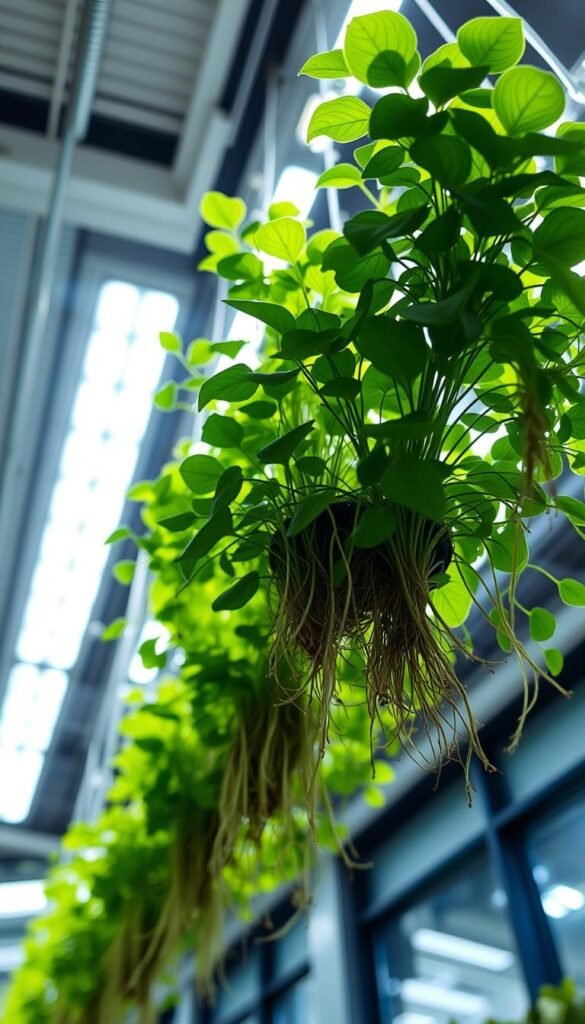
Urban farmers and home growers are turning heads with aeroponics – not just for its futuristic appeal, but for game-changing results. This method grows robust crops while slashing resource use, creating opportunities from studio apartments to rooftop gardens.
Water Conservation and Faster Plant Growth
Aeroponic systems use 95% less water than soil gardening. Roots absorb mist droplets instantly, eliminating runoff. Studies show basil grows 3 weeks faster this way compared to dirt beds.
The nutrient-rich spray feeds plants precisely when needed. Roots don’t waste energy searching for food, so energy goes into leaf and fruit production. You’ll see stems thicken and flowers appear days earlier.
Higher Yields and Healthier Plants
Controlled environments prevent overwatering and soil diseases. Lettuce varieties produce 30% more leaves per cycle, while herbs like mint develop stronger oils for intense flavor. No weeds mean no competition for resources.
Vertical setups let you grow 20 plants in 2 square feet. Leafy greens thrive with consistent mist cycles, yielding harvests every 3 weeks. Tomatoes and peppers often show brighter colors and firmer textures due to optimized mineral intake.
This precision reduces fertilizer waste by 60% compared to hydroponics. Your plants get exactly what they need – nothing more, nothing less. It’s like giving them a tailored nutrition plan instead of a buffet.
Selecting the Ideal Aeroponic System for Beginners
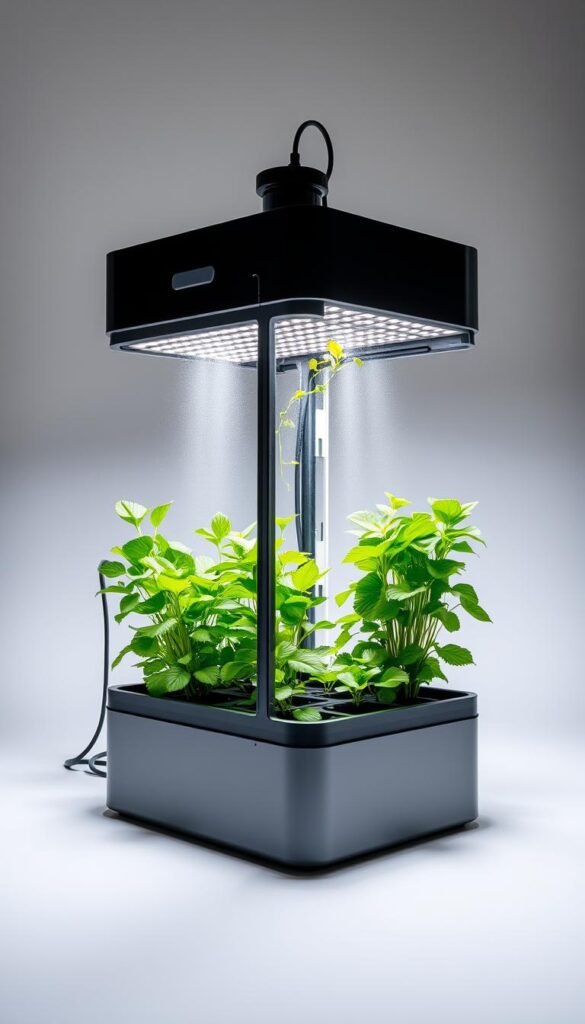
Your aeroponic journey begins with selecting equipment that matches your goals and skill level. Ready-made kits simplify the process, while DIY builds offer customization. Let’s break down your options to find the perfect match.
Pre-Built Kits vs Custom Builds
Commercial systems like Airgarden provide plug-and-play convenience. These kits include pre-tested pumps, timers, and nozzles – ideal for growing herbs and leafy greens. Setup takes under an hour, with apps guiding mist cycles and nutrient levels.
DIY systems cost 60% less but demand technical skills. You’ll source parts like PVC pipes and micro-sprinklers separately. While rewarding, this method requires troubleshooting leaks and uneven spray patterns. Consider your patience level before grabbing a toolbox.
| Factor | Commercial Kit | DIY System |
|---|---|---|
| Cost | $300-$800 | $90-$200 |
| Setup Time | 1-2 hours | 4-8 hours |
| Maintenance | Automated alerts | Manual checks |
| Scalability | Limited | Fully customizable |
Must-Have System Components
Every successful setup needs these core elements:
- Reservoir: Holds nutrient-rich water (5-10 gallon capacity)
- High-pressure pump: Generates mist particles under 50 microns
- Misting nozzles: Distribute solution evenly across roots
- Digital timer: Controls spray intervals (15-30 seconds every 5 minutes)
- Net pots: Secure plants while allowing root expansion
Precision matters most with nozzles and timers. Cheap alternatives clog easily, starving your plants. Start with a compact kit to learn the basics, then expand as your confidence grows.
Setting Up Your Aeroponic Garden
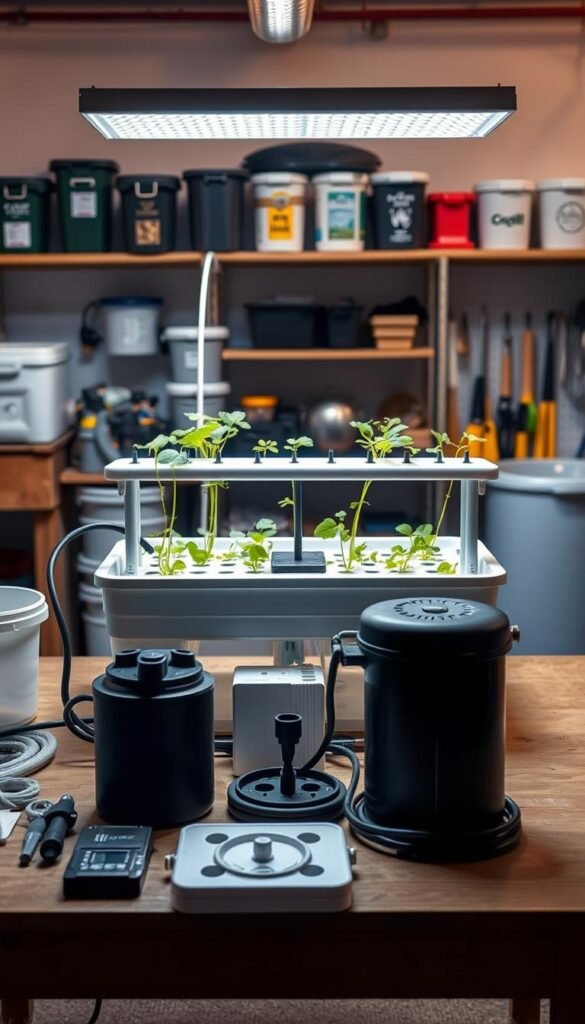
Transform your space into a thriving aeroponic garden with these actionable steps. Proper assembly and calibration ensure your plants receive the ideal balance of air, water, and nutrients for explosive growth.
Step-by-Step Setup Guide
Start by assembling the growing chamber. Connect PVC pipes or vertical towers according to manufacturer instructions. Secure net pots in designated slots, leaving room for root expansion. Follow this sequence:
- Install the reservoir (5-10 gallon capacity)
- Attach the high-pressure pump to misting nozzles
- Program the digital timer for 15-second sprays every 5 minutes
- Test the system with water before adding plants
Use a pH tester to adjust water to 5.8-6.3 range. Most leafy greens thrive in this slightly acidic environment. Check for leaks during the dry run – a common issue first-timers overlook.
Optimizing Your Nutrient Solution and Misting System
Mix hydroponic nutrients at half-strength initially. Brands like General Hydroponics FloraSeries work well for most crops. Increase concentration gradually as plants mature. Track EC (electrical conductivity) levels with a meter:
| Growth Stage | EC Range | Key Nutrients |
|---|---|---|
| Seedling | 0.8-1.2 | Nitrogen, Calcium |
| Vegetative | 1.2-1.8 | Potassium, Magnesium |
| Fruiting | 1.6-2.4 | Phosphorus, Sulfur |
Clean nozzles weekly with vinegar to prevent mineral buildup. Rotate misting heads every 30 days for even coverage. Your system will reward you with vibrant, fast-growing plants that outpace soil-grown counterparts.
Troubleshooting Common Aeroponics Challenges

Even the most efficient systems face occasional hiccups. Recognizing early warning signs keeps your plants thriving without soil. Let’s tackle two persistent issues growers encounter and their science-backed fixes.
Root Health and Nutrient Balance
Slimy roots or yellow leaves signal trouble. Root rot thrives in stagnant air – increase ventilation and reduce mist duration by 20% immediately. Check your nutrient solution weekly with pH and EC meters. Ideal ranges:
| Issue | pH Adjustment | EC Action |
|---|---|---|
| Brown leaf edges | Lower to 5.5-5.8 | Increase calcium |
| Purple stems | Raise to 6.2-6.5 | Boost phosphorus |
| Stunted growth | Maintain 5.8-6.3 | Adjust nitrogen ratio |
Flush reservoirs monthly to prevent salt buildup. Replace mist nozzles every 6 months for consistent droplet size.
Pest Prevention and Climate Control
Spider mites and aphids avoid well-maintained systems. Introduce ladybugs instead of chemical sprays – they devour 50+ pests daily. Keep temperatures between 68-75°F using clip fans or aquarium heaters.
Seasonal changes demand adjustments. Reduce water cycles by 15% in winter to prevent chilling roots. For persistent issues, review hydroponic troubleshooting strategies – many solutions cross over to aeroponics.
Consistency wins. Daily 2-minute checks catch problems before they escalate. Your plants will reward vigilance with uninterrupted harvests.
Advanced Tips for Expanding Your Indoor Garden
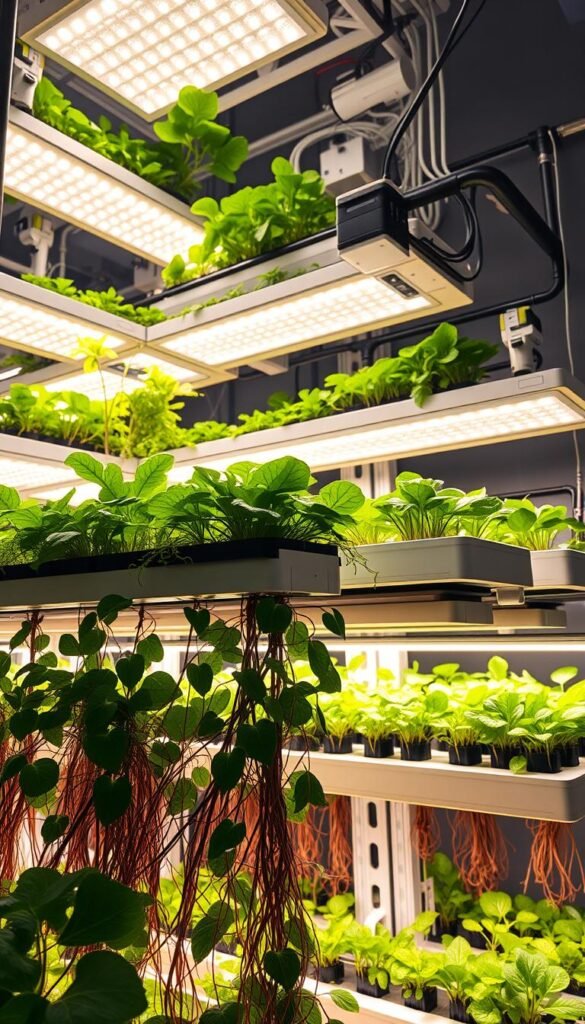
Ready to take your aeroponic setup to the next level? Strategic upgrades can transform a compact grow space into a lush, high-yield oasis. Focus on balancing resource distribution and environmental control as you scale.
Scaling Up Your Aeroponics System Effectively
Start by mapping your available area. Measure vertical and horizontal space – ceiling-mounted racks often double growing capacity. Modular systems let you add towers gradually without disrupting existing plants.
Boost nutrient delivery by upgrading your pump capacity. Larger reservoirs (15+ gallons) maintain stable pH levels for extended root networks. Test misting patterns weekly – dense foliage may require additional nozzles.
Optimizing Lighting and Space Utilization
Full-spectrum LED panels outperform standard bulbs, increasing leaf density by 25%. Position lights 12-18 inches above plants, adjusting height as they grow. Rotate crops every 3 days for even exposure.
Combine vertical stacking with wall-mounted planters to maximize square footage. For inspiration, review hydroponic gardening basics – many space-saving techniques apply to aeroponics.
Recalibrate timers when expanding – larger systems often need 20% longer mist cycles. Track growth rates with a journal to spot efficiency gaps. One urban grower tripled her basil yield simply by realigning lights and adjusting spray intervals.
Beginner’s Guide to Aeroponic Gardening: Benefits & Setup

Growing plants through mist and air requires balancing innovation with routine care. Your success depends on understanding core principles while adapting to your garden’s unique needs.
Essential Growth Strategies
Focus on three pillars for thriving crops: precise nutrition, clean equipment, and regular observation. Maintain your nutrient solution between pH 5.8-6.3 and EC levels matching growth stages. Test weekly using digital meters – deviations stunt plants.
Clean mist nozzles monthly with white vinegar to prevent clogs. Replace filters every 60 days for consistent spray patterns. These simple steps prevent 80% of common issues.
Sustaining Peak Performance
Create a maintenance schedule tailored to your setup. Track these critical factors:
| Task | Frequency | Tool |
|---|---|---|
| pH Testing | Every 3 Days | Digital Meter |
| Root Inspection | Weekly | Flashlight |
| Full System Flush | Monthly | Clean Water |
Rotate plant positions every harvest to equalize light exposure. Gradually increase mist duration as roots mature – young plants need shorter bursts. Document growth patterns to refine your approach season after season.
Remember: healthy roots mean vigorous plants. Keep chambers well-ventilated and temperatures steady. With attentive care, your aeroponics system becomes a self-sustaining source of fresh produce year-round.
Wrapping Up Your Aeroponic Adventure
Your journey into growing plants without soil unlocks remarkable possibilities. Aeroponic systems deliver 95% water savings compared to traditional methods while tripling growth speeds. Imagine plucking fresh herbs every 21 days or harvesting leafy greens year-round – all from a compact, soil-free setup.
Success hinges on routine care. Monitor pH levels (5.8-6.3) and refresh your nutrient solution every 7-14 days. Clean equipment prevents clogs and ensures roots receive oxygen-rich mist. These simple habits keep plants thriving and pests at bay.
Ready to start? Begin with a small system to master mist cycles and root care. As confidence grows, explore vertical stacking or automated sensors. Those expanding their indoor oasis can adapt techniques from indoor hydroponic systems for even greater efficiency.
Every harvest proves aeroponics’ power – crisp produce, minimal waste, and endless adaptability. Revisit this guide as you experiment with new crops or upgrade components. Your greenest garden yet is just a mist cycle away.






